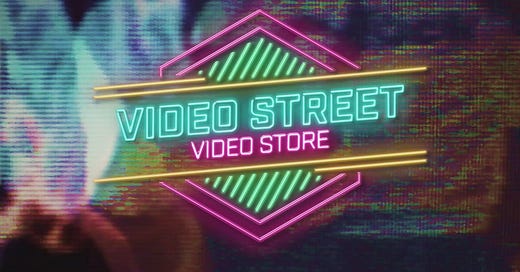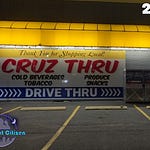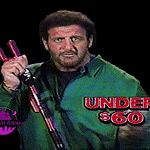And hellooooooo, everybody! Time to go back down again to the VIDEO STREET VIDEO STORE — return some old tapes and pick up some new ones. This week, we’ve got our longest show yet, but that doesn’t mean we’re thinning out the quality! No way, man. We’ve got a short film from Albert Brooks, some behind-the-scenes magic of a Universal Studios fan favorite, a wimpy kid who complains about violent movies on television, and a depraved director who makes them.
So sit back and enjoy! And if you’re new to this here Substack, feel free to go back and check out previous episodes of the VIDEO STREET VIDEO STORE, a regular feature that drops every Tuesday here at Mike’s Bonfire. For future episodes, as well as the big show I do, THE MIDNIGHT CITIZEN podcast, be sure to, ya know…
A new podcast drops every Saturday night.
And now, down to bi’ness!
VIDEO 1: ALBERT BROOKS PRESENTS NBC’S 1979 FALL LINE-UP
As I say in this week’s episode of THE MIDNIGHT CITIZEN podcast (which you should definitely listen to if you haven’t yet), most of the comedy from Saturday Night Live’s early days has not aged well. Of course, that’s a rule of thumb for a lot of stuff SNL has given us over the years — up-to-and-including what just went live on-air as recently as last week. Not that it’s the cast and crew’s fault; the show, by design, is meant to be timely, and as soon as culture moves on, the funny just becomes…irrelevant. While the first 5 years of the show gave us the men and women who were the faces of comedy throughout the 1980s and 90s, the stuff they did on the show now comes across as outdated and, sometimes, embarrassing — like-your-unfunny-parents-trying-to-entertain-your-friends-at-a slumber-party-embarrassing. Just look up any “Coneheads” sketch and you’ll see what I mean.
While this week’s first video may have dated itself with the title alone, I think you’ll still find this short subject Albert Brooks did for SNL pretty spot-on. In fact, if you laugh at all, it’s proof that the comedian was then what he later became known best for — a master satirist whose biggest target was always the medium that fed him.
Before Brooks sent-up movies with his first feature, Real Life (1979), he was given a contract by SNL producer Lorne Michaels to produce a series of short films. The deal was Brooks’s preferred alternative to what Michaels really wanted from him, which was for him to be the permanent host of Saturday Night. Brooks’s deal kicked in immediately, and his first film — a repackaging of the short that had initially brought him to Michaels’ attention, “The Famous School for Comedians,” is probably the best thing of the show’s pilot, which featured George Carlin as the host, and introduced us to Chevy Chase, John Belushi, Gila Radner, and all the rest of the original “Not Ready for Prime Time Players.”
For the next several years, Brooks routinely churned out short films. I may be a little biased, because ever since I first saw Lost in America (1985), I’ve held the guy up as one of my greatest comedy influences, but I believe all his early SNL shorts still hold their value — especially the one we’re watching this week, a pointed satire of the homogenous banality of network television programming. Though you can see Brooks being funny as the proverbial man-in-the-middle in “The Three of Us,” my favorite gag here is the promo for “Black Vet,” about a scarred Vietnam vet who becomes an animal doctor in a small, racist southern town. They don’t make em’ like that anymore…which is probably a good thing.
VIDEO 2: THE COMPUTER “MAGIC” BEHIND “T2: 3D”
I’m embittered by this week’s second tape — partly because it gives me the bad memory of finding out in the mid-90s, at the height of my prepubescent “Terminator” fandom, that a new one was being made, but that I’d have to go all the way to stupid Universal Studios in Florida to see it. Mostly, now, it irritates me at how much this Discovery Channel documentary kisses the asses of the computers that generated all the effects for this stage show that combined live stunts with pre-filmed ones.
There was definitely a golden age of computer generation — where not only were they a marvel to behold on the silver screen, but the public was captivated with how much movie magic could be achieved without ever having to build a practical model. This era of the public’s fascination with CG began around 1989 with James Cameron’s The Abyss, and really hit a fever pitch a couple years later with his follow-up film, Terminator 2, which gave us mind-bending visual effects of Robert Patrick as the T-1000 morphing, contorting, and folding his liquid metal self all over the damn place. For the next few years, you couldn’t flip the dial on your TV without seeing some behind-the-scenes special about how they generated this or how they manipulated that. When Jurassic Park came out in ‘93 and became the biggest movie ever, it was commonplace for years thereafter to see a documentary special about how they merged live-and-computer effects to create the realistic dinosaur action.
I think a major reason for why we were fascinated with computer generation in the ‘90s is, well, because it was the 90s and the computer was the machine of that era. Who knew what all it was capable of? But, also, I believe we were awed by specials like this week’s “T2: 3D” tape because we saw computers as something that could add to the action — not be the whole damn equation. I think if you go back and look at the extensive archives of TV specials like this one that go behind-the-scenes on production, as well as all the DVD special features for effects-heavy movies like The Abyss, as well as Independence Day, Twister, The Mummy, et. al, you’ll find a general slowing down of “How They Did That” documentaries by the early 2000’s. At some point, we just got tired of looking at guys sitting at their computers in some boring office in Burbank, California, showing you how they built wireframe dinosaurs. It was like watching the magician explain to you over and over again, using the same words, how he pulled the rabbit out of the hat. As a young 20-something who had grown up watching Discovery Channel’s “Movie Magic,” fascinated by how they did stunts like the helicopter crash in Cliffhanger, the in-camera forced perspective tricks of Honey, I Shrunk the Kids, and, of course, the CG effects in Terminator 2, I got extremely tired, and eventually, very irritated at any big summer movie that came out that only used CG. I especially remember seeing Star Wars: Episode 1 in 1999 and saying to myself, “So, is this what it’s gonna be now?”
I eventually did get down to see “Terminator 2: 3D” at Universal Studios-Florida in 2016, just a couple months before it finally shut down. I sat there in that old, cold theater and marveled at how the show, meant to look so futuristic, was ironically a time capsule of an era that was not too far in the physical past, but, by today’s standards, might as well have been an exhibit from one of those old World’s Fairs where they showed you how great technology is and how grand the future will be. Seriously, it felt like I was on the Carousel of Progress. I couldn’t believe how antiquated the effects looked, how cheesy it looked to have the live actors interact with their on-screen counterparts, how clumsy and ill-convincing the old CG looked. To really enjoy it, I just had to put myself in the mind of a pre-teen me who, in the 1990s, had something that I so rarely find myself possessing today: an optimism for entertainment. It made me sad that the “movie magic” is kind of over, that we can no longer expect to go to the movies — or theme park attractions — and be wowed by what we see there.
I don’t know. Maybe I’m looking too much into this tape. Let’s talk about another flick from the early 90’s that captivated me every bit as much as T2: Judgment Day. I’m talking, of course, about…Batman.
VIDEO 3: “BATMAN RETURNS” GETS CRUCIFIED ON DAYTIME TELEVISION
A few weeks back, I showed you the tape from 1991 where actress Sean Young had a come-apart on The Joan Rivers Show after she wasn’t cast as “Catwoman” in Batman 2. Continuing the theme we’ve got going here on The VSVS of “Batman” and Daytime talk shows, here’s a tape from June 1992 of the angry parent mob dismissing what was by then the decade’s most anticipated sequel as vile, violent filth.
The 1990s was the heyday of parental backlash, and don’t you miss it so much? As opposed to today when parents just give their kids phones so’s the tykes won’t distract them when they’re on social media, protesting how much of a rot social media is? Back then (again, it seems so long ago now), the parents mobilized, man. They went before Congress, pressured the music and video game industries into rating their content, and ultimately inspired my favorite number from 1999’s South Park: Bigger, Longer, and Uncut (“Come on, you know the words!”).
My mom, God bless her, was not one of these moms. She had me there on opening day, June 19, 1992 — first show — to see what I had probably refused to shut up about for months:
“But mom!!! It’s the Bat, the Cat, and the Penguin!”
Of course, this morning show is not about what the parents think, but what, um, the “kids” think about the controversy surrounding Batman Returns — how it’s marketed to young kids, and how, as USA Today Junior Movie Critic, 10-year-old Danny Slaski, says, “Everything that kids love is used against them — clowns…. Even the penguin had a ducky boat.” Come on, Danny. That’s what you think. Really?
I’m sure if they pulled the camera back just a few feet, you’d see his mom — or Bradley Curl, the “head of an organization that promotes family home entertainment” — sitting just behind him, stuffing their hands up there.
Sure, Danny had a point. Batman Returns was, up to that point in my 9-year-old life, the most violent movie I had ever seen. But man did I love it. It wasn’t that the movie was very good. I watched it recently, for the first time in years, and really thought it was kind of average. However, back in 1992, Batman 2 was the first movie I had ever gone to where I was consciously aware of the rating — PG-13 — and I felt like seeing it was a right-of-passage of sorts to teen-hood. I remember even pressuring my mom to sit alone in the theater so I could feel more independent. She obliged, and for the next two hours, I felt a little bit older.
And isn’t that what violent movies made for kids are all about? Allowing them to test their ever-expanding freedom in a controlled, safe place?
When I watch this tape, I just can’t help but feel sorry for Danny, and how every time he says things like, “It’s just too violent for kids,” the camera cuts to reaction shots of bemused kids in the audience, who clearly can’t wait to catch that kid in the lobby and kick his ass.
Today, we have controversy that’s so clearly engineered (just see the Chick-Fil-A summer camps story I talked about on this week’s show), and if this talk show clip from 1992 proves anything, it’s that nothing has changed in 30 years.
VIDEO 4: “HENRY: PORTRAIT OF A CANCELLED FILM”
If little Danny Slasky was horrified by Batman Returns, but not by the MUCH-more-violent Terminator 2, then I wonder where he stood on Henry: Portrait of a Serial Killer, John McNaughton’s movie from 1988 that was so vile, so violent, so debauched that hardly anyone saw it until the mid-90’s.
Seriously. Not even the Motion Picture Association of America would touch it.
As McNaughton says in this interview with local Chicago television — and two of the most Chicago people who ever lived, like SNL’S super fans on steroids — it wasn’t so much the violence that the MPAA objected to, but the tone. And, yeah, I see what they’re talking about. I mean, I’ve seen Henry only twice, and have been so disgusted and disturbed by it that I’ve sworn it off for the rest of my life. However, I consider it one of the greatest movies ever made. The title says it all: this is the “portrait” of a serial killer. It is not the distillation of a murderer you see on A&E or listen about on true crime podcasts, where detectives and criminologists can explain to you m.o.’s and motivations. The film is like looking into the uncanny valley of an artist’s self-portrait, looking for some meaning — some expression — that explains it all, and feeling disheartened to find that there is none. It is just instinct that the animal in that painting has that you don’t, and never will.
Is this making sense? If you’ve seen Henry, I think it does.
At the end of the day, Henry: Portrait of a Serial Killer is not exploitation in the "True Crime” podcast sense. It is a mature film that really tries to examine the perversion, psychopathy, and senselessness that is baked into some of humanity’s random brains, and also why we began to see such proliferation of these violent people in the second half of the twentieth century. The film seems to be searching for Henry’s motivation, as well as that of his sidekick Otis Toole. Is it their collective poverty? How they linger and lurk in a bleak urban landscape? Ultimately, the film comes up with nothing — just Henry leaving Chicago — and Otis’s head — behind him, and moving onto another town.
This interview with McNaughton and his distributor is an excellent capsule of what I think it must have been like to live as true filmmaker in the 80s. At the time, many of the restrictions on sex and violence had been regulated thanks to the MPAA, but to have your art probe something deep about the human psyche, getting to a place so dark that not even light can escape it, well, there’s really no way for Blockbuster to categorize that.
Well, that’s it for this week’s VIDEO STREET VIDEO STORE! Again, be sure to, ya know…
A new episode of the VSVS drops every Tuesday throughout the summer, and, of course, be sure to check out THE MIDNIGHT CITIZEN, your late night broadcast from Birmingham, AL, hosted by me, Mike Boody, every Saturday night. Keep your eyes open!














Share this post